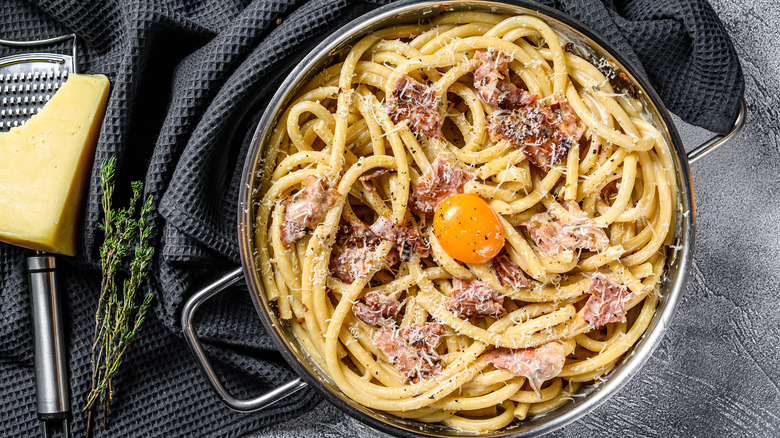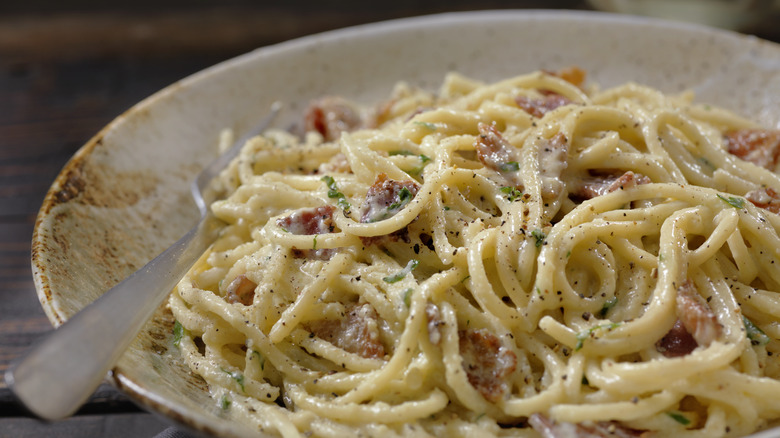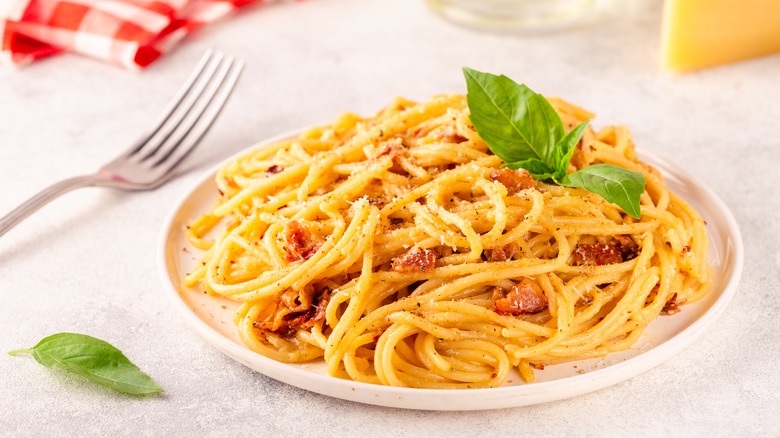The Absolute Best Pasta Variety To Use For Carbonara
Carbonara is a classic, ready-in-no-time pasta dish that's easy enough to whip up once you've given it a few tries. Its ingredients are fairly simple and can be made mostly with things you already have in your pantry. Put simply, carbonara "sauce" is made by whisking eggs with pecorino romano, then using the heat from pasta water to create a creamy sauce and cook the egg slightly. Guanciale, or pig jowl, is traditionally added as well, though other fatty cured pork products such as pancetta or bacon are suitable substitutes. Of course, you'll want to choose the perfect pasta — something that the sauce can grip onto so that you get that delicious carbonara flavor in every bite.
A longer pasta shape is a great option here. Some think bucatini stands above the rest — even celebrity chef Geoffrey Zakarian agrees. "Bucatini is one of my favorite pastas," Zakarian said on an episode of Food Network's "The Kitchen." It's his pasta of choice for carbonara, and he describes it simply: "thick spaghetti with a hole in it," which separates it from many other pasta types and gives the sauce plenty of places to go when it's tossed with the pasta.
Why bucatini is the best choice for carbonara
Bucatini is a pasta shape that can be difficult to create by hand, so if you don't have a pasta maker, you're better off purchasing a fresh or dried version from the store. When it comes to carbonara, an elongated pasta type is commonly used, so while it's not unusual to see it made with spaghetti (and arguably even more common), that small hole in the bucatini means the sauce has plenty of places to stick — not just on the outside of the pasta but also on the inside, making for an extra saturated bite.
When shopping for bucatini or making your own, pay attention to the type of flour used. Pasta traditionally fares best when made with a hard, high-protein wheat flour, such as semolina; its higher gluten content makes it more flexible. Double zero flour, or tipo 00, is arguably even better than semolina due to its gluten content, but it's not always easy to find in the United States. A local Italian market may be your best bet for finding fresh pasta made with double zero.
Pasta shape does matter
When it comes to making homemade carbonara, you can technically use whatever pasta you want. But believe it or not, the particular pasta shape does matter when it comes to sauce. Thinner, more delicate noodles like capellini are best when paired with super light sauces, such as a thin tomato sauce or olive oil-based sauce; you don't want them to be too weighed down. A heavier sauce, like a Bolognese, needs a thicker pasta type, such as pappardelle — that greater surface area makes it easy to get plenty of sauce in each bite.
For something with a creamy texture, like Alfredo or carbonara, you'll want a pasta type that has more heft than angel hair but not as much as pappardelle. That's where a pasta like bucatini comes in. Any longer noodle with great surface area will work here, so if you don't have bucatini on hand or can't find it in your local grocery store, then you can still make a near-perfect carbonara using another option, such as spaghetti or even fettuccine. While carbonara is traditionally paired with a thinner pasta, such as spaghetti, it's time to break barriers and give bucatini its chance in the carbonara spotlight.


